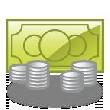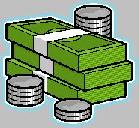
 |
|
| Financial Terms | |
| Process costing |
|
Information about financial, finance, business, accounting, payroll, inventory, investment, money, inventory control, stock trading, financial advisor, tax advisor, credit.
Main Page: business, inventory, payroll, financial advisor, accounting, finance, stock trading, financial, |
Definition of Process costing
Process costingA method of costing for continuous manufacture in which costs for an accounting compared are compared with production for the same period to determine a cost per unit produced. Process costingA costing methodology that arrives at an individual product cost through the calculation of average costs for large quantities of identical products.
Related Terms:FIFO method (of process costing)the method of cost assignment that computes an average cost per equivalent modified FIFO method (of process costing)the method of cost assignment that uses FIFO to compute a cost per process costing systema method of accumulating and assigning costs to units of production in companies producing large quantities of homogeneous products; strict FIFO method (of process costing)the method of cost assignment that uses FIFO to compute a cost per equivalent unit and, in transferring units from a department, keeps the weighted average method (of process costing)the method of cost assignment that computes an average cost per cost of production reporta process costing document that  equivalent units of production (EUP)an approximation of the number of whole units of output that could have been hybrid costing systema costing system combining characteristics First in, first-out costing method (FIFO)A process costing methodology that assigns the earliest Corporate processing floatThe time that elapses between receipt of payment from a customer and the Diffusion processA conception of the way a stock's price changes that assumes that the price takes on all In-house processing floatRefers to the time it takes the receiver of a check to process the payment and Price discovery processThe process of determining the prices of the assets in the marketplace through the Absorption costingA method of costing in which all fixed and variable production costs are charged to products or services using an allocation base. Activity-based costingA method of costing that uses cost pools to accumulate the cost of significant business activities and then assigns the costs from the cost pools to products or services based on cost drivers.  Job costingA method of accounting that accumulates the costs of a product/service that is produced either Lifecycle costingAn approach to costing that estimates and accumulates the costs of a product/service over Target costingA method of costing that is concerned with managing whole-of-life costs of a product/service during the product design phase – the difference between target price (to achieve market share) and the target profit margin. Variable costingA method of costing in which only variable production costs are treated as product costs and in which all fixed (production and non-production) costs are treated as period costs. activity based costing (ABC)A relatively new method advocated for the absorption costinga cost accumulation and reporting activity-based costing (ABC)a process using multiple cost drivers to predict and allocate costs to products and services; attribute-based costing (ABC II)an extension of activitybased costing using cost-benefit analysis (based on increased customer utility) to choose the product attribute backflush costinga streamlined cost accounting method that speeds up, simplifies, and reduces accounting effort in an environment that minimizes inventory balances, requires business process reengineering (BPR)the process of combining information technology to create new and more effective cost-benefit analysis the analytical process of comparing therelative costs and benefits that result from a specific course direct costingsee variable costing full costingsee absorption costing job order costing systema system of product costing used joint processa manufacturing process that simultaneously life cycle costingthe accumulation of costs for activities that multiprocess handlingthe ability of a worker to monitor process benchmarkingbenchmarking that focuses on practices and how the best-in-class companies achieved their results process complexityan assessment about the number of processes through which a product flows processing timethe actual time consumed performing the process mapa flowchart or diagram indicating every step process productivitythe total units produced during a period process quality yieldthe proportion of good units that resulted from the activities expended product- (or process-) level costa cost that is caused by the development, production, or acquisition of specific products or services relevant costinga process that compares, to the extent possible statistical process control (SPC)the use of control techniques that are based on the theory that a process has natural variations in it over time, but uncommon variations target costinga method of determining what the cost of a variable costinga cost accumulation and reporting method Ito processStatistical assumptions about the behavior of security prices. For Absorption costingA methodology under which all manufacturing costs are assigned Activity-based costing (ABC)A cost allocation system that compiles costs and assigns Direct costingA costing methodology that only assigns direct labor and material costs Kaizen costingThe process of continual cost reduction that occurs after a product ProcessA series of linked activities that result in a specific objective. For example, the Work-in-process inventoryInventory that has been partially converted through the Purchased In-Process Research and DevelopmentUnfinished research and development that is acquired from another firm. Process flow productionA production configuration in which products are continually Reprocessed materialMaterial that has been reworked and returned to stock. Work-in-processAny items being converted into finished goods or released from KaizenA method of costing that involves making continual, incremental improvements to the kaizenthe Japanese word for continuous improvement Related to : financial, finance, business, accounting, payroll, inventory, investment, money, inventory control, stock trading, financial advisor, tax advisor, credit. |